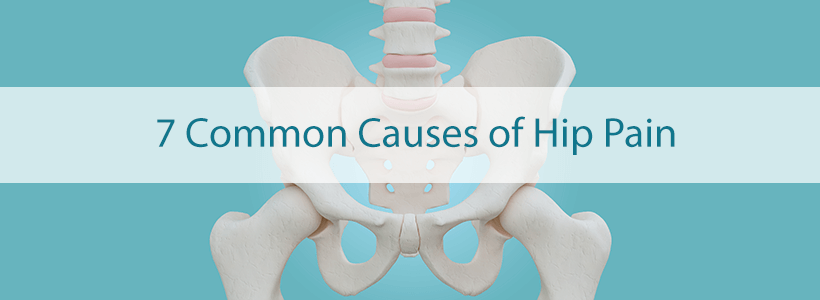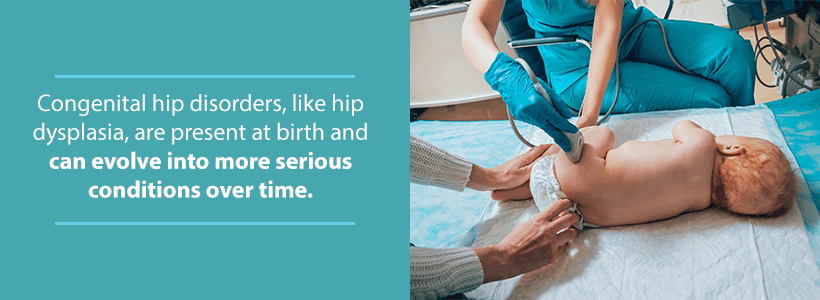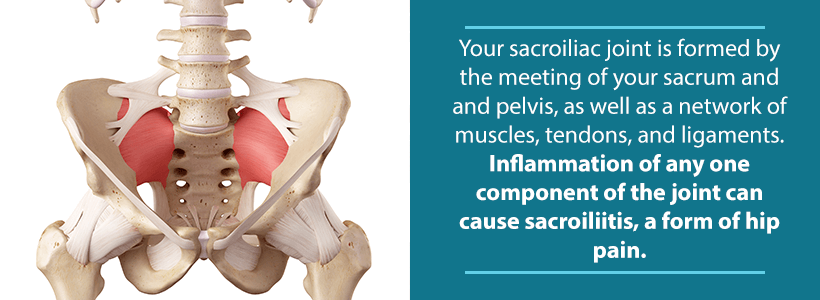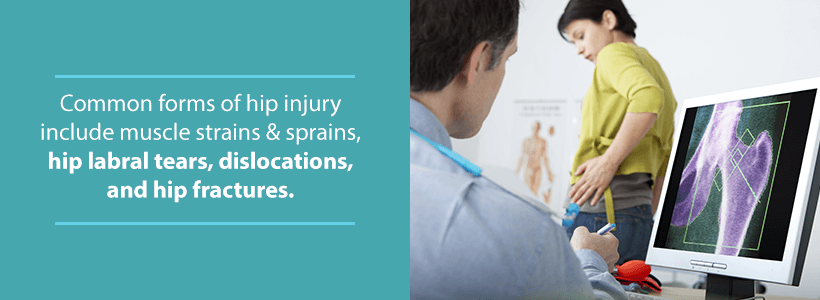If you’re dealing with frequent back or neck pain, your posture might be playing a bigger role than you think. Whether you're sitting at a desk all day or scrolling on your phone for hours,…
Your hip is among the largest—and most vulnerable—joints in your body.
Like the shoulder, your hip is considered to be a “ball-and-socket” joint. The ball-like head of the femur (aka the thighbone) fits into a shallow divot in the pelvis, known as the acetabulum. This ball-and-socket-esque structure affords your hip with the freest range of motion of any joint type in the body.
Imagine, for example, all of the ways in which you can use your hip to revolve your extended leg. Now, imagine the limited ways in which you can use your knee (a hinge joint) to give motion to your calves. In comparison, you’re pretty much limited to up and down extension and flexion of the knee.
Because the hip is so mobile, it’s also prone to injury and wear and tear. We use our hips constantly in daily life: to walk, climb the stairs, support our weight, and maintain our balance. Congenital defects in hip anatomy, repetitive strain, a misstep while walking… all of these things can affect the mobility of the hip and lead to hip pain.
Added to this is the fact that your hip is rich with anatomy. A fine system of muscles, nerves, tendons, and ligaments support the hip and pelvis. For example, your gluteus maximus, quadricep, hamstring, abductor, and adductor muscles all assist your hip in creating movement. The sciatic and femoral nerves also pass through the hip to supply sensation to the thighs. And, interspersed between all of these structures are fluid-filled sacs called bursae that reduce friction as muscles, tendons, and bones slide and glide past one another. Inflammation in any one of these areas can (and often does) lead to hip pain.
General Sources of Hip Pain
It can be useful to break hip pain down into categories based upon more generic causes. For example: Is the source of your hip pain congenital (or present at birth)? Or, did your hip pain emerge after years of overuse? Did your hip pain result from an injury? Or, do you simply have a pinched nerve? As we review the most common sources of hip pain, we’ll keep these considerations in mind. However, of the many conditions that we’re about to discuss, most don’t fall neatly into any one category.
Congenital Hip Disorders
Congenital hip disorders are a class of hip problems that are present at birth. And—by far and away—the most common of these deformities is hip dysplasia.
- Hip Dysplasia: Also known as Developmental Dislocation of the Hip, hip dysplasia occurs when the ball-and-socket joint of the hip does not fit together properly. This can arise when:
-
- The head of the femur isn’t round enough
- The acetabulum (socket) that holds the femur into place isn’t deep enough
This excess wiggle in the joint can lead to dislocations at birth and accelerated wear and tear in later life.
Wear & Tear Disorders:
Degenerative (or “wear and tear”) disorders develop after the hip has sustained years of repetitive strain or overuse. Because your hips are weight-bearing structures, these disorders occur commonly with obesity or with occupations that involve all-day sitting, standing, or heavy lifting. A lot of the following disorders can also be caused—or worsened—by injuries.
- Hip Osteoarthritis: Osteoarthritis of the hip occurs when the cartilage that coats the femoral head and acetabulum begins to break down. Because cartilage serves to reduce friction, it’s absence means that the femur and pelvis will grind together instead of glide. In addition, this can cause inflammation, bone spur development, the hardening of hip ligaments, and pinched nerves.
- Sacroiliitis: Your sacroiliac joint is formed by the meeting of the sacrum (the triangular bone at the bottom of the spine) and the ilium (or pelvis). Sacroiliitis literally means inflammation of the sacrum and it is caused by excess wobble in this joint. Like hip dysplasia, this disorder can be congenital. But, more often than not, sacroiliitis results from chronic strain or lax ligaments during pregnancy.
- Tendinitis: Tendons are soft tissues that connect muscles to bone. When a muscle becomes overworked, tight, or weak, it can pull on the tendon in unusual ways. Ways that often lead to tenderness or hip pain. The sore tendons in question may connect the hip to the glutes, hamstrings, hip flexors, quadriceps, psoas, or groin muscles.
- Trochanteric Bursitis: Your femur (or thighbone) contains several raised ridges and knobs of anatomical significance. Not counting the head of the femur, one of the largest of these is the greater trochanter. Your greater trochanter is lined with bursae, or fluid-filled sacs that facilitate the movement of muscles and tendons over bone. Inflammation of these bursae can lead to hip, thigh, or buttocks pain.
Injury-Related Hip Disorders
Hip injuries can occur instantaneously—regardless of how healthy your hip joint may be. Car accidents, falls, sports injuries… Each of these events can cause a variety of hip injuries, from hip fractures and dislocations to soft tissue injuries. Some of the most common hip injuries that we see in our practice include:
- Strains & Sprains: A strain occurs when a tendon or muscle that supports your hip suffers a sudden tear. In contrast, sprains involve the ripping of ligaments. (Although the distinction seems a little like splitting hairs.) Both of these traumatic events can result from collisions (whether with the ground or your opponent in sports) or from overworking the muscles without properly stretching first.
- Hip Labral Tears: Your labrum is a swatch of cartilage that wraps around and protects your acetabulum, or hip socket. (Incidentally, you also have a labrum that lines each shoulder socket, aka the glenoid cavities.) Hip labral tears occur when this cartilage rips, leaving the hip socket exposed to direct contact from the femur.
Nerve Impingement Disorders:
The last class of hip disorders that we’ll be discussing involves interruption or damage to the nerves that pass over and through the hips. These disorders include:
- Pinched Nerves / Sciatica: A pinched nerve in the hip occurs when either bony anatomy or soft tissue swelling compresses nerve tissue, firing signals of pain into the hips and/or legs. If the sciatic nerve is the pinched nerve in question, then the resultant disorder is known as sciatica. However, many nerves—including the femoral nerve—can suffer pinching and produce symptoms of hip pain.
A Final Word on Hip Pain & Disorders
The hip is a complex joint, rich in anatomy and rife with the potential for things to go wrong.
If you have been suffering from hip pain, then don’t hesitate to contact your doctor. Many of the disorders that produce hip pain have similar symptoms. So, diagnosing hip pain can be a challenge. You need the expert wisdom of a board-certified orthopedist, who can accurately diagnose your pain and get you on the road to recovery.
To discuss minimally invasive and conservative treatments for hip pain, contact our award-winning hip specialists at Orthopedic & Laser Spine Surgery today!




